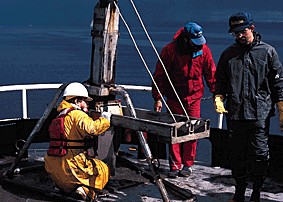


For instance, Oceanography Professor Jody Deming is testing microorganisms to see if they might clean up badly contaminated marine sediments. Bainbridge Island's Eagle Harbor provides a working lab for her researchers because the harbor floor is part of a Superfund site.
The work by Deming's team, however, is not being funded by the EPA but by the Office of Naval Research. The basic research under way at Eagle Harbor could find ready application elsewhere in Puget Sound, the state and the nation, including Navy installations and shipyards, Deming says.
Among other things, a series of creosote plants polluted Eagle Harbor sediments with polycyclic aromatic hydrocarbons (PAHs) in concentrations a hundred times greater than current state limits. In some of the worst spots, concentrations are a thousand times greater. PAHs are toxic to all plant and animal life except for certain tiny creatures that not only tolerate PAHs, they eat them. Some of these families of microorganisms have long made Puget Sound --including Eagle Harbor--their home.
Deming and her colleagues are trying to determine which microorganisms may be able to clean the harbor floor, if there are things that could be done to encourage them or things that should be avoided because they will slow or stop the activity.
The research at Eagle Harbor is some of the first in the nation dealing with organisms found in marine sediments. Of the half a dozen institutions working on polluted marine sediments, UW has the largest program and the only one that spans the disciplines of oceanography, microbiology, medical genetics, fisheries, forestry and civil and chemical engineering. Up to 30 undergraduates a quarter have participated in research expeditions or lab work.
The program is being supported in its first five years with $4 million from the Office of Naval Research and the UW's provost office.
APL: Vietnam Era Target Is Now More Open
Cold War Inventions May Help Save the Earth
APL Home Page
Send a letter to the editor at columns@u.washington.edu.